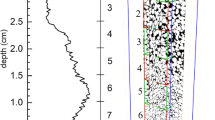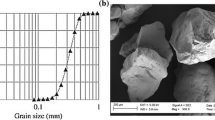Abstract
Natural gas-hydrates are valuable energy resource with rich deposits, and their thermal transport and thermal dynamic mechanical behaviors significantly affect the long-term production process and phase change-based thermal energy storage characteristics of these energy resources. This paper aims to propose novel relations to predict the thermophysical properties, to investigate the hydrate phase evolution in microstructures, and to study the thermal transport and thermal dynamic mechanical properties. Hydrates formation experiments in sandpack samples and ultrasonic wave tests are conducted with the aid of X-ray CT imaging. Digitalization microstructures models and variables are defined to describe the hydrate phase evolution, and novel relations are proposed to accurately predict the thermophysical properties based on the microporosity and ultrasonic wave velocities. The thermal transport and thermal dynamic mechanical properties in microstructures with hydrate, water, residuary pore and grain phases are studied. Results show that the average errors of porosity, P-wave and S-wave velocities between the experimental data and computed results by the proposed relations are less than 5%, indicating the accuracy and reliability of the proposed method. The temperature fraction decreases with increasing underground temperature and decreasing hydrate saturation. The thermal stress and thermal displacement increase as temperature and hydrate saturation increase. There are strong anisotropy for the temperature fraction, thermal stress and thermal displacement during the thermal transport of hydrates.
Similar content being viewed by others
References
Kolchanova E A, Lyubimova T P. Interface instability of methane hydrate deposits of variable permeability under permafrost conditions. Int J Heat Mass Transfer, 2016, 98: 329–340
Yin Z, Linga P. Methane hydrates: A future clean energy resource. Chin J Chem Eng, 2019, 27: 2026–2036
Zhao J, Wang J, Liu W, et al. Analysis of heat transfer effects on gas production from methane hydrate by thermal stimulation. Int J Heat Mass Transfer, 2015, 87: 145–150
Yang M, Fu Z, Jiang L, et al. Gas recovery from depressurized methane hydrate deposits with different water saturations. Appl Energy, 2017, 187: 180–188
Ning F, Yu Y, Kjelstrup S, et al. Mechanical properties of clathrate hydrates: Status and perspectives. Energy Environ Sci, 2012, 5: 6779–6795
Choi S, Park J, Kang Y T. Experimental investigation on CO2 hydrate formation/dissociation for cold thermal energy harvest and transportation applications. Appl Energy, 2019, 242: 1358–1368
Sun R, Fan Z, Yang M, et al. Experimental investigation into the dissociation of methane hydrate near ice-freezing point induced by depressurization and the concomitant metastable phases. J Nat Gas Sci Eng, 2019, 65: 125–134
Shagapov V S, Khasanov M K, Musakaev N G, et al. Theoretical research of the gas hydrate deposits development using the injection of carbon dioxide. Int J Heat Mass Transfer, 2017, 107: 347–357
Wang H N, Chen X P, Jiang M J, et al. Analytical investigation of wellbore stability during drilling in marine methane hydrate-bearing sediments. J Nat Gas Sci Eng, 2019, 68: 102885
Liu Y, Hou J, Zhao H, et al. Numerical simulation of simultaneous exploitation of geothermal energy and natural gas hydrates by water injection into a geothermal heat exchange well. Renew Sustain Energy Rev, 2019, 109: 467–481
Yin Z, Moridis G, Tan H K, et al. Numerical analysis of experimental studies of methane hydrate formation in a sandy porous medium. Appl Energy, 2018, 220: 681–704
Wang Y T, Zhou X P, Kou M M. Three-dimensional numerical study on the failure characteristics of intermittent fissures under compressive-shear loads. Acta Geotech, 2019, 14: 1161–1193
Wang Y, Zhou X, Wang Y, et al. A 3-D conjugated bond-pair-based peridynamic formulation for initiation and propagation of cracks in brittle solids. Int J Solids Struct, 2018, 134: 89–115
Sun Y H, Zhang G B, Carroll J J, et al. Experimental investigation into gas recovery from CH4-C2H6-C3H8 hydrates by CO2 replacement. Appl Energy, 2018, 229: 625–636
Wu Z, Li Y, Sun X, et al. Experimental study on the gas phase permeability of montmorillonite sediments in the presence of hydrates. Mar Pet Geol, 2018, 91: 373–380
Liu L, Lu X, Zhang X. A theoretical model for predicting the spatial distribution of gas hydrate dissociation under the combination of depressurization and heating without the discontinuous interface assumption. J Pet Sci Eng, 2015, 133: 589–601
Wang Y, Feng J C, Li X S, et al. Analytic modeling and large-scale experimental study of mass and heat transfer during hydrate dissociation in sediment with different dissociation methods. Energy, 2015, 90: 1931–1948
Feng Y, Chen L, Suzuki A, et al. Numerical analysis of gas production from layered methane hydrate reservoirs by depressurization. Energy, 2019, 166: 1106–1119
Sun X, Luo T, Wang L, et al. Numerical simulation of gas recovery from a low-permeability hydrate reservoir by depressurization. Appl Energy, 2019, 250: 7–18
Zhou X P, Zhang J Z, Wong L N Y. Experimental study on the growth, coalescence and wrapping behaviors of 3D cross-embedded flaws under uniaxial compression. Rock Mech Rock Eng, 2018, 51: 1379–1400
Wang J Q, Zhao J F, Yang M J, et al. Permeability of laboratory-formed porous media containing methane hydrate: Observations using X-ray computed tomography and simulations with pore network models. Fuel, 2015, 145: 170–179
Zhao Z, Zhou X P. An integrated method for 3D reconstruction model of porous geomaterials through 2D CT images. Comput Geosci, 2018, 123: 83–94
Liu L, Dai S, Ning F, et al. Fractal characteristics of unsaturated sands —Implications to relative permeability in hydrate-bearing sediments. J Nat Gas Sci Eng, 2019, 66: 11–17
Kou M, Liu X, Tang S, et al. 3-D X-ray computed tomography on failure characteristics of rock-like materials under coupled hydro-mechanical loading. Theor Appl Fract Mech, 2019, 104: 102396
Zhao Z, Zhou X. Digital energy grade-based approach for crack path prediction based on 2D X-ray CT images of geomaterials. Fatigue Fract Eng Mater Struct, 2019, 42: 1292–1307
Yang S Q, Yin P F, Huang Y H, et al. Strength, deformability and X-ray micro-CT observations of transversely isotropic composite rock under different confining pressures. Eng Fract Mech, 2019, 214: 1–20
Lei L, Seol Y, Choi J H, et al. Pore habit of methane hydrate and its evolution in sediment matrix—Laboratory visualization with phase-contrast micro-CT. Mar PetGeol, 2019, 104: 451–467
Zhao Y, Zhao J, Shi D, et al. Micro-CT analysis of structural characteristics of natural gas hydrate in porous media during decomposition. J Nat Gas Sci Eng, 2016, 31: 139–148
Yu C, Ji S, Li Q. Effects of porosity on seismic velocities, elastic moduli and Poisson’s ratios of solid materials and rocks. J Rock Mech Geotech Eng, 2016, 8: 35–49
Xu Z, Shi W, Zhai G, et al. A rock physics model for characterizing the total porosity and velocity of shale: A case study in Fuling area, China. Mar Pet Geol, 2019, 99: 208–226
Castagna J P, Batzle M L, Eastwood R L. Relationships between compressional-wave and shear-wave velocities in clastic silicate rocks. Geophysics, 1985, 50: 571–581
Eskandari H, Rezaee MR, Mohammadnia M. Application of multiple regression and artificial neural network techniques to predict shear wave velocity from wireline log data for a carbonate reservoir, southwest Iran. Can Soc Explor Geophys Rec, 2004, 9: 40–48
Palomar I, Barluenga G. Assessment of lime-cement mortar micro-structure and properties by P- and S-ultrasonic waves. Construct Build Mater, 2017, 139: 334–341
Boumiz A, Vernet C, Tenoudji F C. Mechanical properties of cement pastes and mortars at early ages. Adv Cement Based Mater, 1996, 3: 94–106
Sussman M, Smereka P, Osher S. A level set approach for computing solutions to incompressible two-phase flow. J Comput Phys, 1994, 114: 146–159
Olsson E, Kreiss G. A conservative level set method for two phase flow. J Comput Phys, 2005, 210: 225–246
Servio P, Englezos P. Morphology of methane and carbon dioxide hydrates formed from water droplets. AIChE J, 2003, 49: 269–276
Author information
Authors and Affiliations
Corresponding author
Additional information
This work was supported by the National Natural Science Foundation of China (Grant Nos. 51839009 and 51679017).
Rights and permissions
About this article
Cite this article
Zhao, Z., Zhou, X. Digital microstructure insights to phase evolution and thermal flow properties of hydrates by X-ray computed tomography. Sci. China Technol. Sci. 64, 187–202 (2021). https://doi.org/10.1007/s11431-020-1579-x
Received:
Accepted:
Published:
Issue Date:
DOI: https://doi.org/10.1007/s11431-020-1579-x




